Oktoberfest 2011 - Sunday "Trachten" Parade
 Tuesday, September 20, 2011 at 8:00
Tuesday, September 20, 2011 at 8:00 Oktoberfest opens with a Saturday parade - the breweries march to the Wiesn and the mayor taps the first keg.
The next day, Sunday, has a longer parade that focuses on the traditional dress/costumes (trachten).
The marchers came from all over Bavaria & Germany, plus Austria, Switzerland, Italy, and even Hungary!
This blog post won't go in parade order, like the Saturday parade, but will be organized by topic:
- Couples and Flower Arches
- Ladies and Gentlemen
- Children
- Hunting, Horses, and Marching Bands
- Commercial and non-trachten participants
Introduction
Each of the 60 marching groups (!) was preceeded by a number marker -- a program was sold with information about each segment: where they're from, how old the local/regional costume is, and other interesting details.
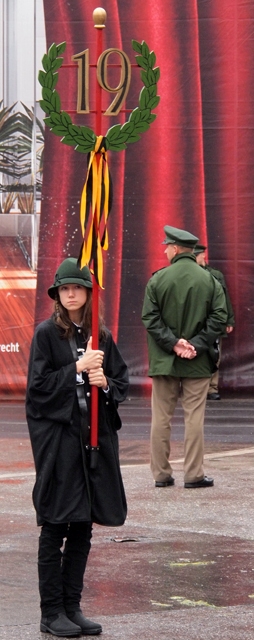
(Note: the entire parade included 8500 participants and took almost 3 hours to run!
I tried to document here as much as possible about where the people and outfits come from...)
Many towns or regions brought their own banner or standard to lead their part of the procession.
For example, the town of Lindhorst is in Niedersachsen (state of Lower Saxony) in northern Germany:
Another example: 16th century / medieval outfits from Upper Bavaria:
Freising is a town near the Munich airport, and home to a colleague of mine - quite a standard to bear too:
Another example were the memorable blue & white uniforms from the town of Eschwege in Hessen:
Some marchers also carried flags and performed tosses (these from Konstanz, near the Swiss border):
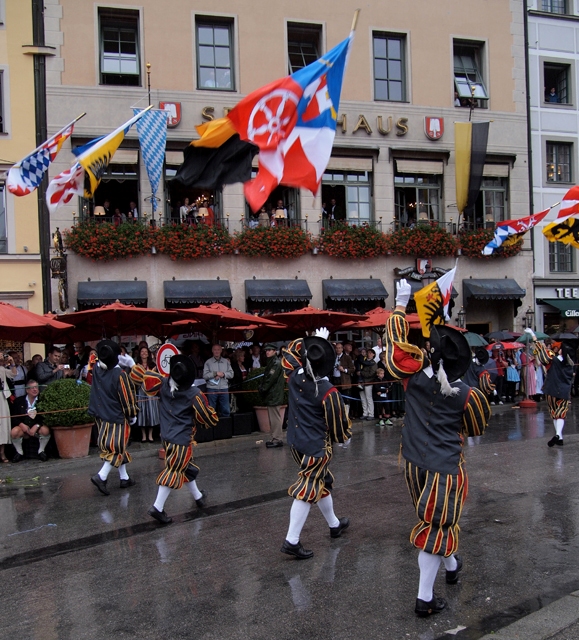
This lady from the Hacker-Pschorr brewery was great: she pulled up her dirndl for a peek at her garter.
Look at the expression on the Asian couple's faces on the left side - makes a memorable Oktoberfest...
The jesters added some moves to their walk through Munich:
In addition to costumes and marching bands, there was more traditional music -
here two Swiss men stopped to play the Alpine horns!
They are from Auenstein, in the north-west of Switzerland. And here is the video!
Couples (plus Flower Arches)
Here are some typical trachten outfits (mostly not lederhosen, and less cleavage than Oktoberfest today):
Finally -- the first nice German beard:
The traditional costumes ranged from the conservative, almost colonial...
... to slightly more frilly with some interesting accessories (his hat, and in his left hand?)...
(The funky hats are local - Munich - but the design inherited from a region in Romania. Interesting!)
... to even more interesting accessories -- the next photo has a substantial hat/head ornament...
(outfits are from the Franconia area of Germany which includes Northern Bavaria & part of Thuringa)
...to some that have a strong eastern European flavor. (Again, representatives from Lower Saxony.)
One interesting aspect was the prevalence of plant and flower arches, in all sizes and colors.
I don't know the meaning or significance of these, but they were quite lovely.
Some were carried along by themselves:
A group from the state of Hessen brought bright arches, with their wide red "ascots" dating to 1900:
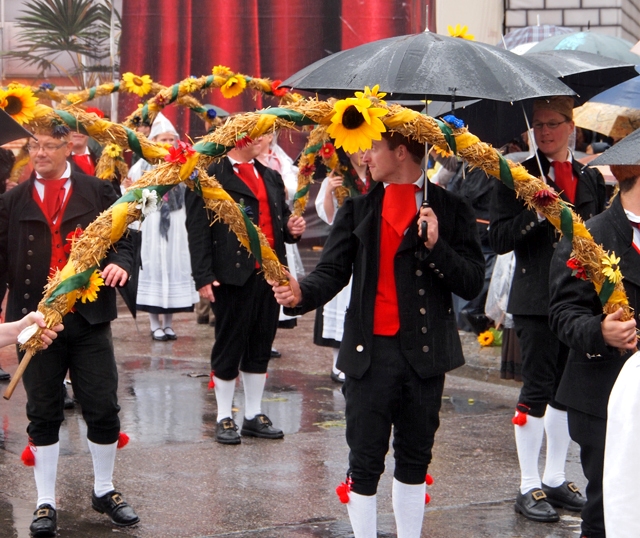
Other flowers were carried by men, with a woman under the arch...
(strangely, these marchers from from a sports association outside Regensburg, Bavaria):
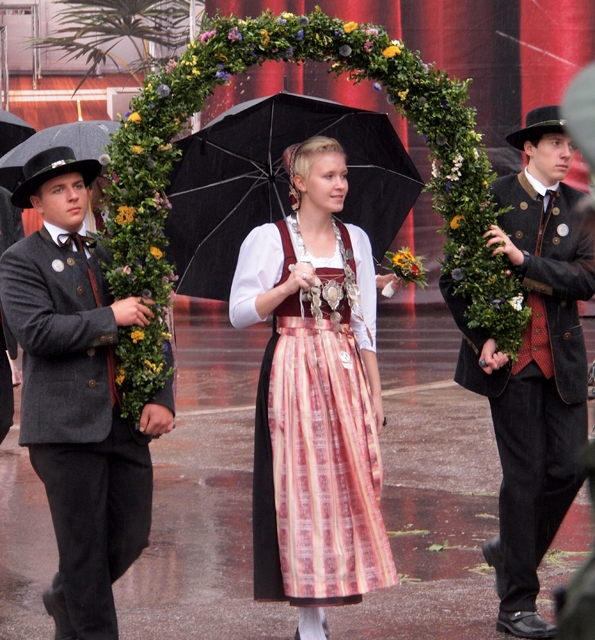
...others were carried by women with a man under the arch...
(notice how the men are "decorated" - indications of authority... könig means "king")

...still others were carried by men with a man in the middle. Again, I don't know why.
According to the program, almost all of these photos are of people from local sports associations.
Maybe it's some of their local individual or team champions??? Any readers know?
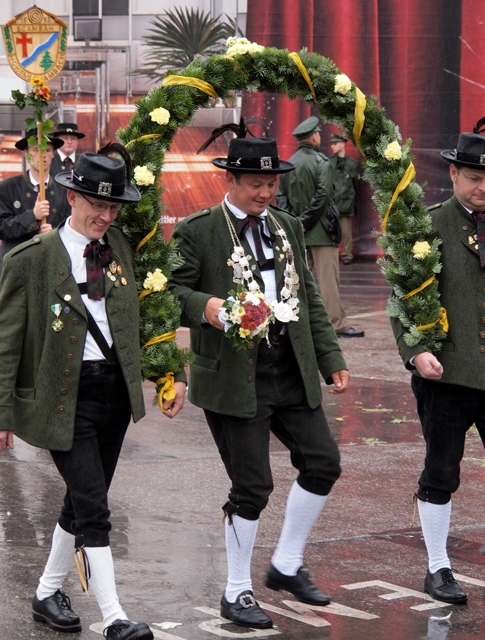
Some flowers were colorful and large -- must have taken a long time to prepare everything:
One in particular was more complex, with something like a crown on top:
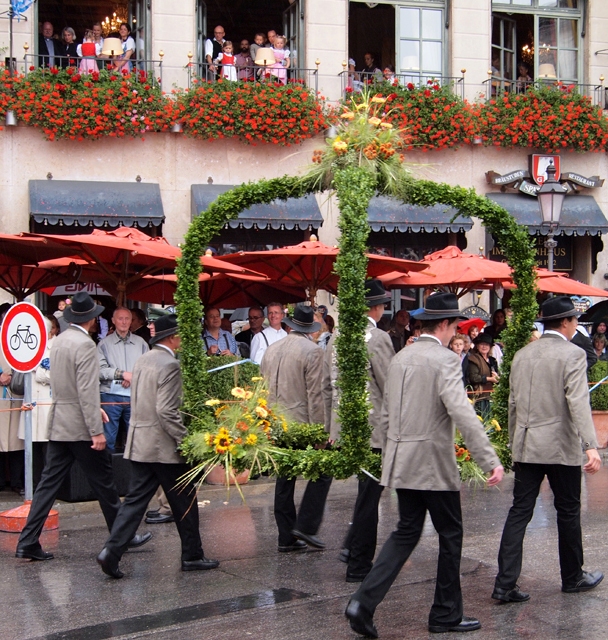
Maybe the prior photo was similar to a maypole, which was also present in the parade (below)?
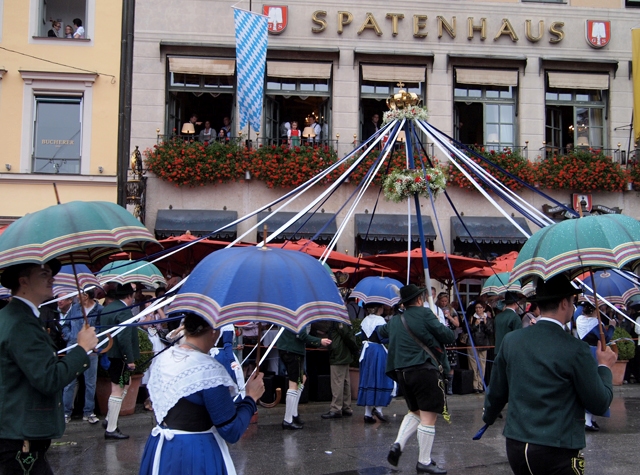
If you look closely, you can sometimes see town seals or crests that show where they're from:
Here is a video showing what the flower arches looked like en masse, as they went by:
The flower arches were one of the nicest parts of the parade:
Ladies and Gentlemen
Again, some outfits were quite soft and subdued. Below is more 16th century / medieval dress from Bavaria.
(Naturally, these remind me of a Renaissance fair or Robin Hood.)
The ladies almost always carried flowers:
The costume below comes from upper Bavaria (men in background have lederhosen, of course).
These are classic dirndls, hats, and suits for the guys - would look fantastic in an Oktoberfest tent:
Notice the hops on her hat (below) and her carrying two silver bells - the program states that the silver chain (and probably bells too) are traditional in that Bavarian town, but doesn't explain why/any meaning behind them:
The weather was terrible - cold and rainy. Umberllas in the crowd and over the participants:
These were the ladies from Zala, Hungary! Folk costumes (cattle herding) are from the late 14th century:
Again, we saw some fascinating hats. First one (below) is made of otter fur.
These are fishermen's/women's attire from Starnberg, outside of Munich.
The hats below from the Black Forest region, in the German state of Baden-Württemberg:
And the eastern European influence shows up yet again in traditional costumes from Lower Saxony:
Other accessories ranged from traditional purses (and "eagle's feather" in the hat)...
...to full baskets...
...to old fashioned Franconian vegetable/harvest baskets strapped over the back...
...to horns with flowers (the first of the three photos is a woman from Bruneck, Italy!)...
Other flowered horns come from Bavaria (next photo, below):
The third lady with a horn + flowers comes from Percha, Italy:
The best: tiny beer kegs / wine barrels!!! The guys in these towns are lucky, unless the ladies don't share.
The first example comes from Chiemsee, outside of Munich. Coins are just ornamental, no significance:
The last one is a traditional costume from Ebersberg (Bavaria) from around 1800:
As for the men, some costumes were just dapper (below from Dachau, outside Munich)...
...but many had a military-like background (below is Munich's city police corps, uniforms from 1813):
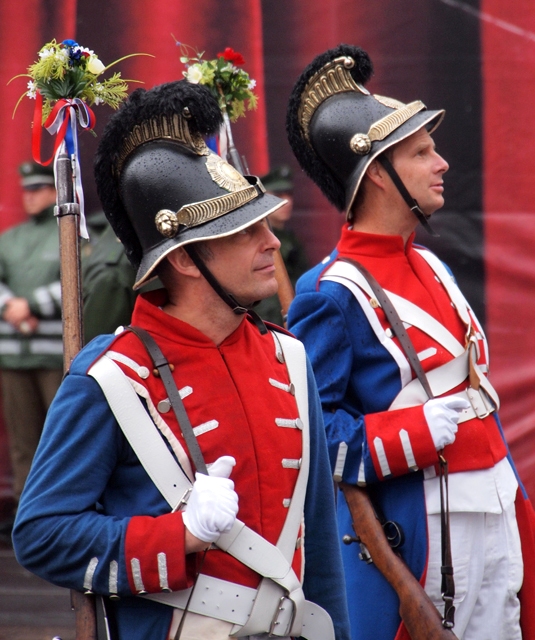
Next is a military uniform from Baden-Württemberg from the mid-1800s:
Their accesories were swords as well as guns (below from Tegernsee, Bavaria, not far from Munich):
Uniforms of others had a feel of command or authority (commander, mayor, etc.).
The man below was marching with a band from Königsdorf, another Upper Bavarian town.
The next man represents Vigo di Fassa, Italy. It's in the Dolomite Mountains, so culturally similar...
I can't explain this accessory, but read that it comes from the Augustiner brewery in Munich.
His uniform (below) is from Augustiner's Oktoberfest band.
Here we have guns, an wood antler-like rake, an axe, and spear. The marchers' outfits commemorate the peasants' uprising of 1705 during the "Bloody Christmas" in Sendling, Bavaria.
The traditional dress (photos above & below) are from Bavaria and date to 1800.
The lederhosen and well-groomed moustache should give the origins away!
And this flag bearer also carried a mace!!! (Flag is covered with plastic due to the rain.)
This last male accessory was a large pair of cowbells that this guy would swing back & forth:
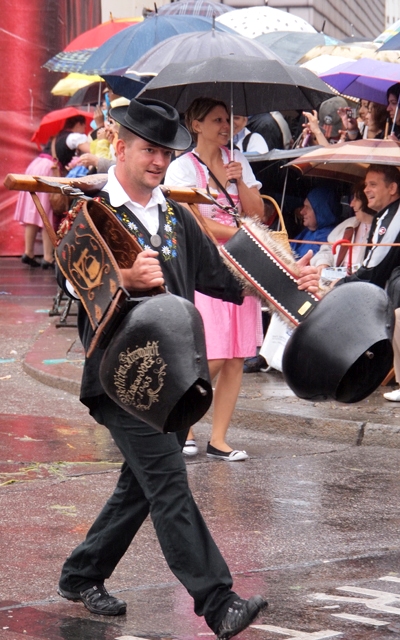
He was part of the group from Switzerland, where men played the very long Alpine horns.
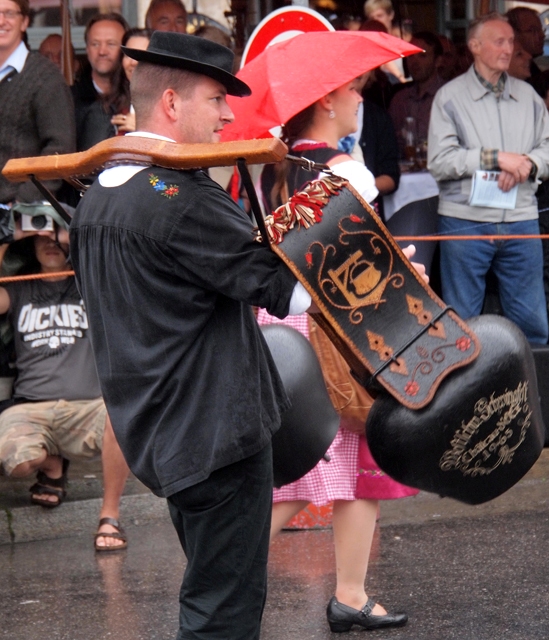
Children
The cutest part of the procession. The next two girls come from Baden-Württemberg.
The ornamentation on these outfits is "according to family status".
...but not always happy with the rain puddles all along the route:
These were almost toy soldier uniforms... and this boy has a big teddy bear!!! The uniforms are from the Hacker-Pschorr band, inherited from the Crown Prince Second Infantry Regiment (1805), Bavaria.
Love the colors on her below -- she's from a Polish youth organization in Munich:
Nice outfit from Konstanz (near the Swiss border), and he got to be a flag bearer:
Finally, a tiny princess in her wagon, from nearby Markt Schwaben in Munich. Cute overload.
Hunting, Horses, and Marching Bands
Hunting was a common theme of the marching groups as well. They brought their dogs, AWESOME.
Photos (and the video) below are from the Hunting Association of Bavaria:
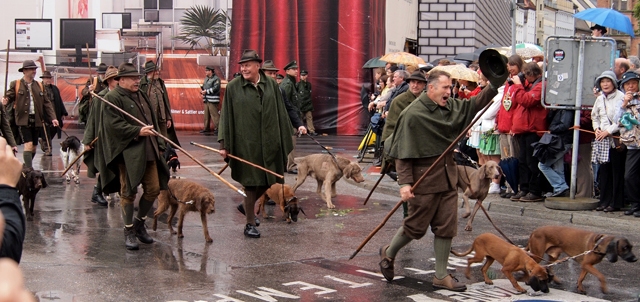
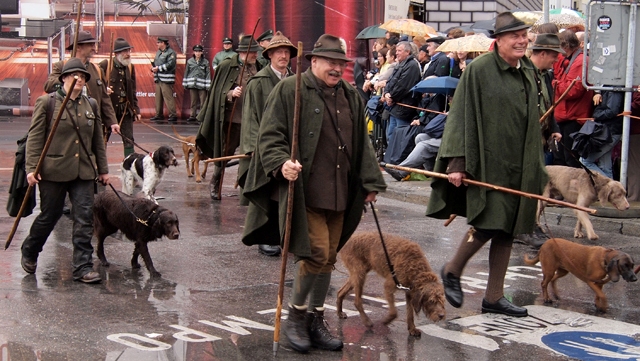
Check out the video -- they brought a falcon as well. This was really cool:
This was interesting -- a princess of hunting and texidermy? She would do well in Texas.
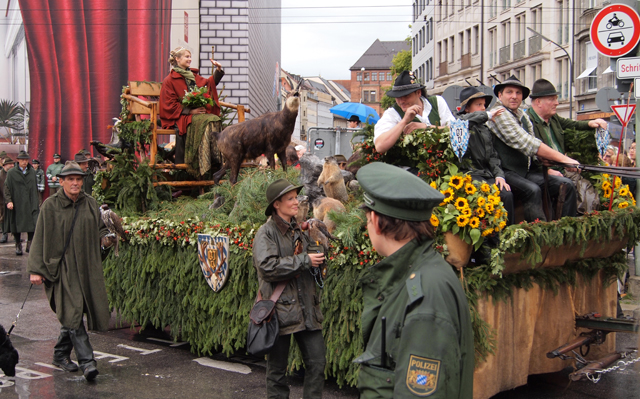
Look at all the taxidermied animals! (And there is the hunting falcon again, lower right.)
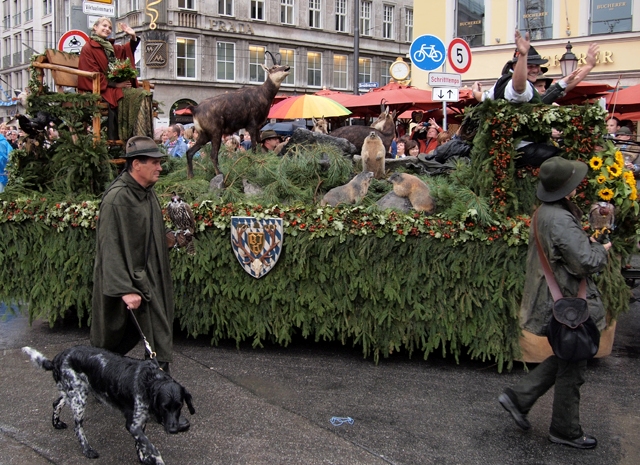
I don't know the story behind this one, but it must be pretty good. Not your usual parade wagon:
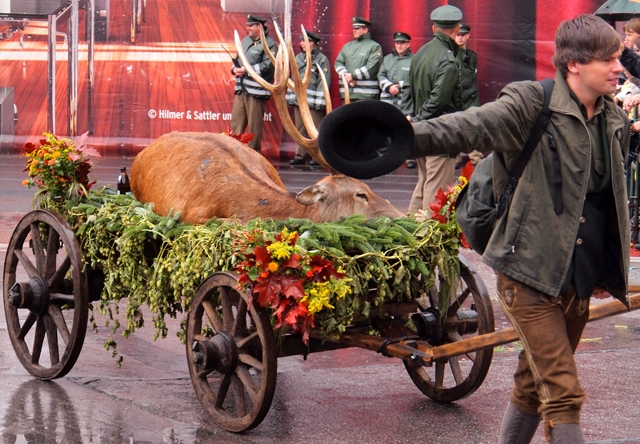
The hunters had colorful outfits as well, including rifles (again, medieval dress from Bavaria)...
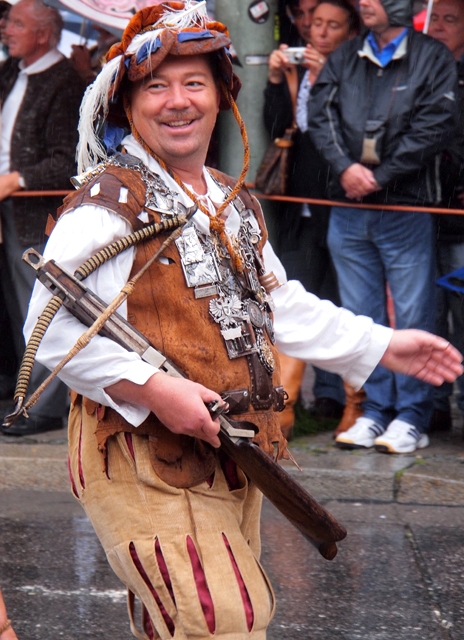
...and crossbows. These were not just hunters, but also Bavarian mercenaries back in the day!
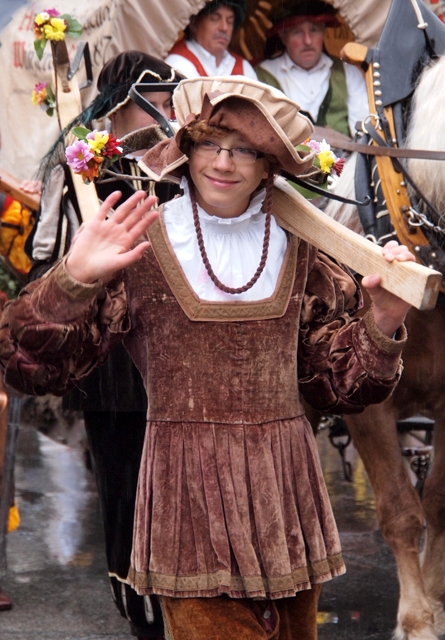
Another outdoor activity was represented: a float the looked like a traditional river raft.
These types of rafts were used since 1300 on the river Kinzig in Baden-Württemberg:
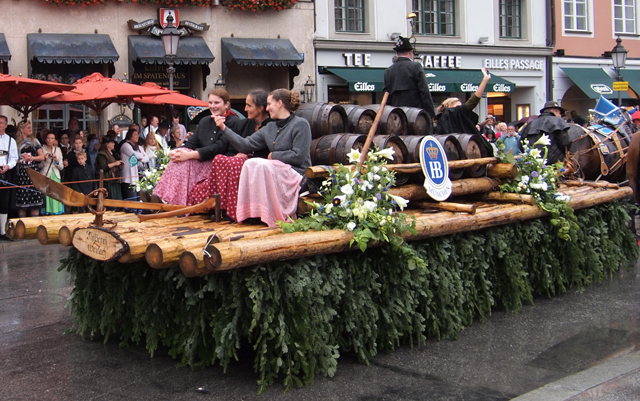
The strangest: traditional "feathering" (colonial activity, ladies separated the feathers for pillows, etc.):
Ladies showed some traditional dress on the horses as well:
Of course, the horses themselves were decked out nicely (note the German beard on the driver too):
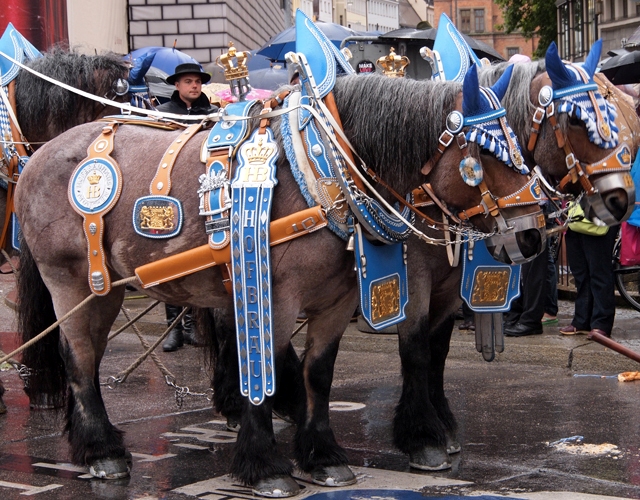
Some carts were not blessed with a big, strong team of horses (LOL):
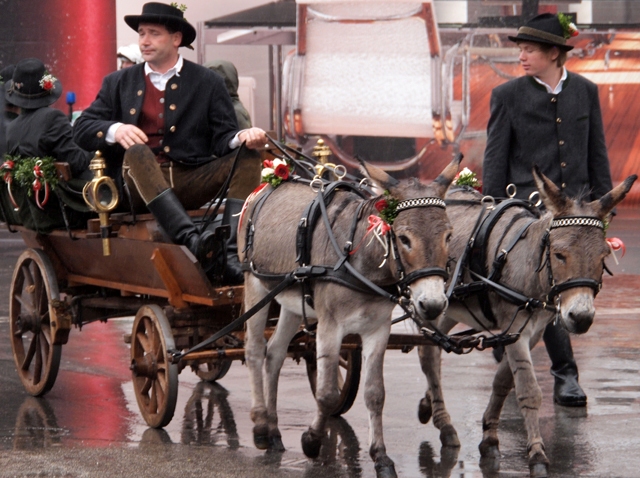
The marching bands also used traditional uniforms:
Some uniforms had great assessories, like this headpiece (represents a halo?).
This marching band comes from the German state of Baden-Württemberg, Bavaria's neighbor:
The bands also used some old fashioned instruments too:
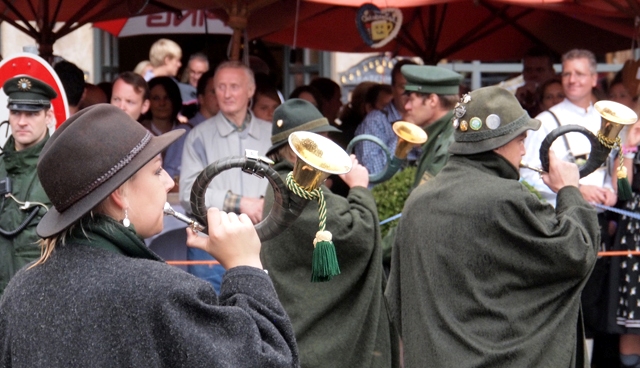
Photos above and below are hunting horns from the Bavarian Hunting Association:
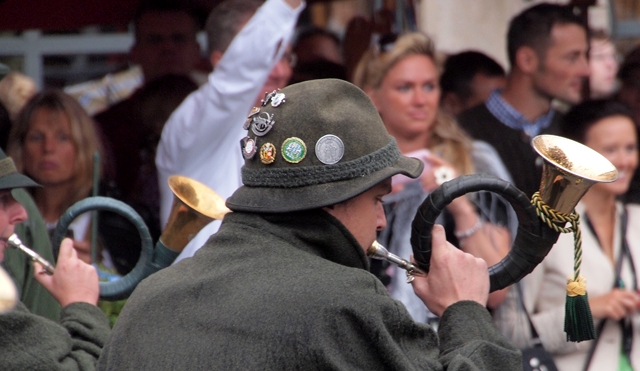
This folk music / marching band with leading ladies came from Folgaria, Italy.
Commercial and non-trachten participants
First things first: there was a weissbier keg cart in this parade, after the first marching band!
The first commercial sponsor of the parade? BMW of course!
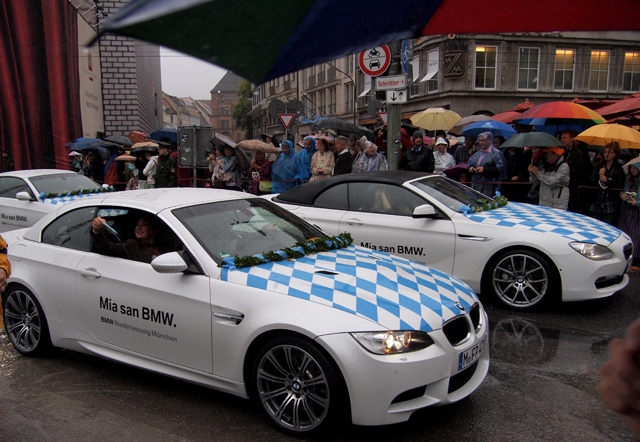
The car rental company Sixt (also a partner with BMW) had an "oom-pah" band playing on their float:
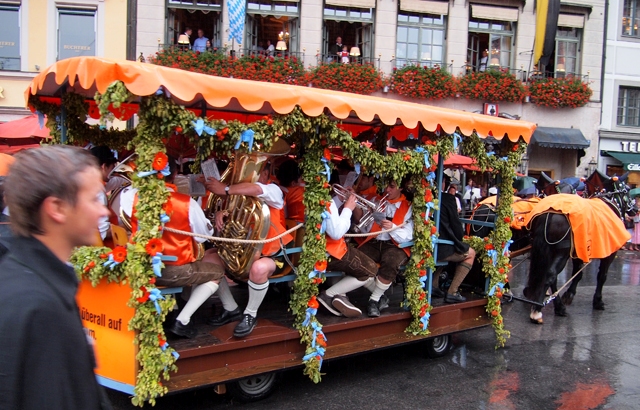
An old-fashioned fire truck drove through...
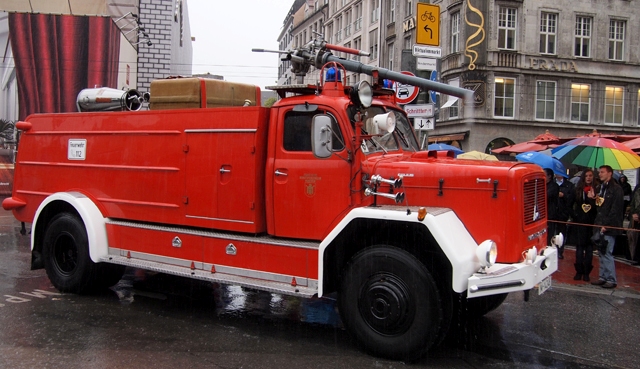
...and a float of firemen in traditional uniforms. The guy in front is not looking happy in the rain.
This was the voluntary Munich Fire Brigade's uniform in 1895.
Bavarian farming was represented too (not surprising), with this large tractor from the company BayWa:
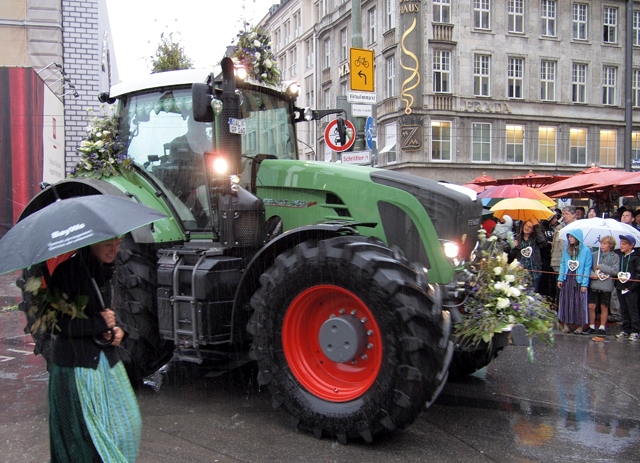
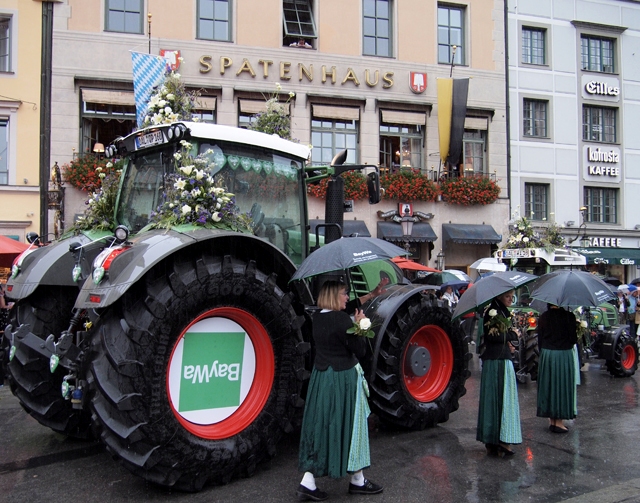
Milk farmers of Bavaria also had a spot. I love the complaining German woman on the left:
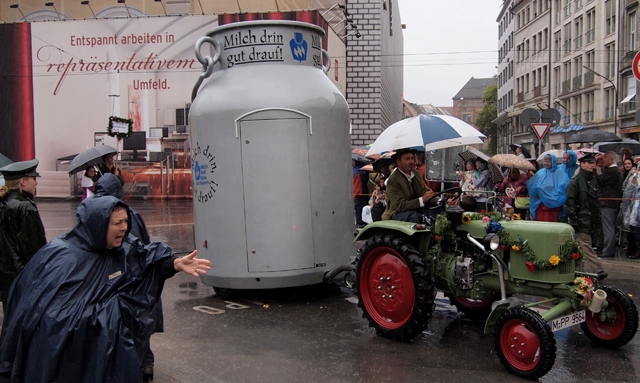
Multi-person bike tours took the advantage to advertise... but the larger beer/party bikes have been banned!
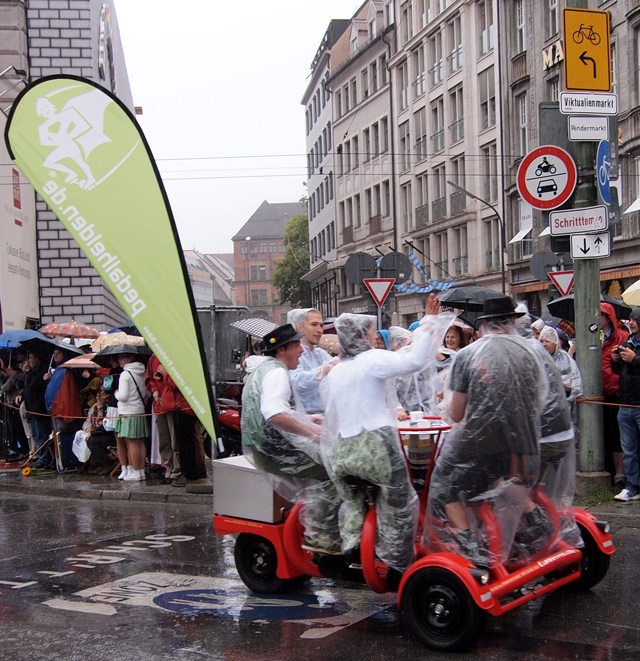
This float had something to do with Russia and Moscow -- they threw pretzels from the stacks to the crowd...
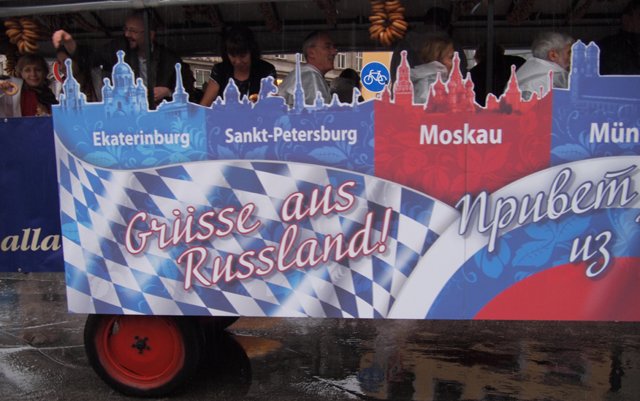
... and I caught one! Even though it never hit the ground, it was damp and soggy. Did not eat it.
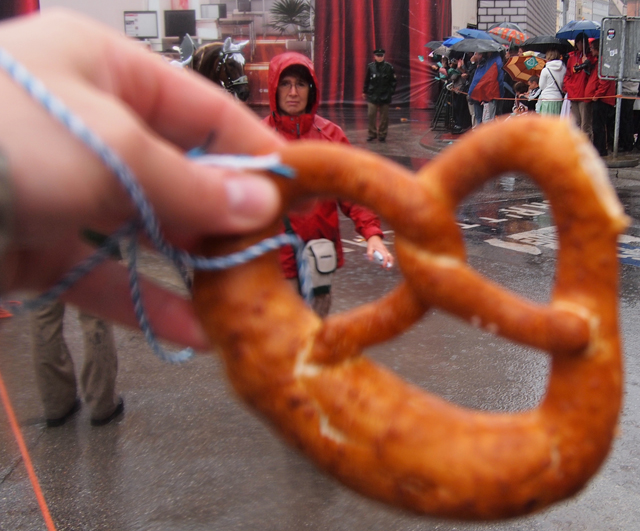
The last photo: a float from Narrhalle reminded everyone that Fasching (Mardi Gras) is just a half year away....
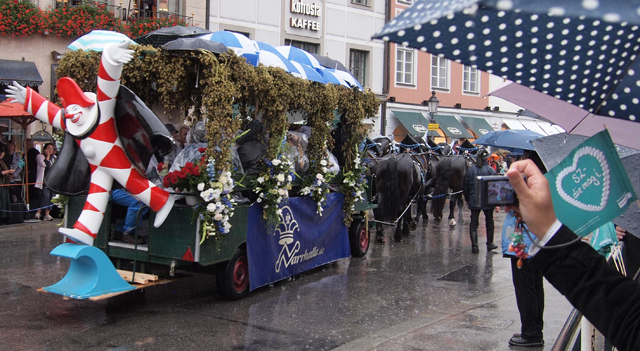
 Herr J ...
Herr J ...  Post a Comment
Post a Comment  Germany & German Culture tagged
Germany & German Culture tagged  Oktoberfest,
Oktoberfest,  parade,
parade,  trachten
trachten  2 References ...
2 References ...  Print Article
Print Article  Email Article
Email Article 



